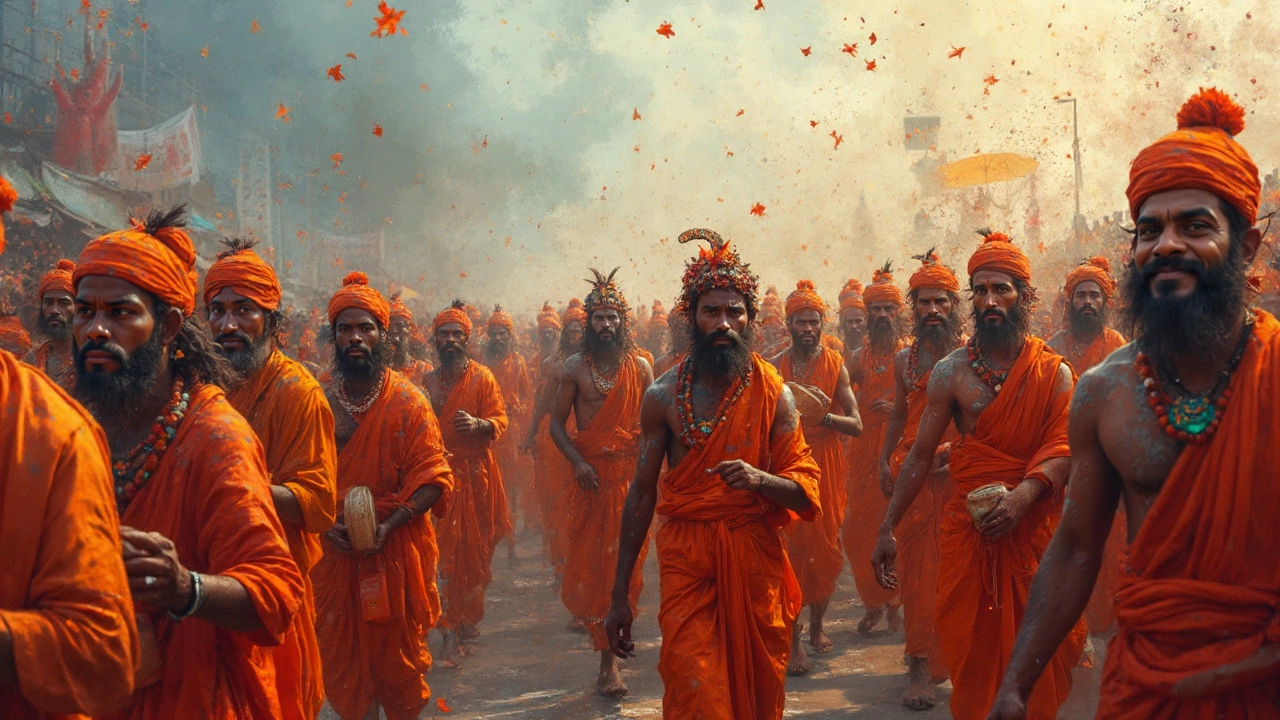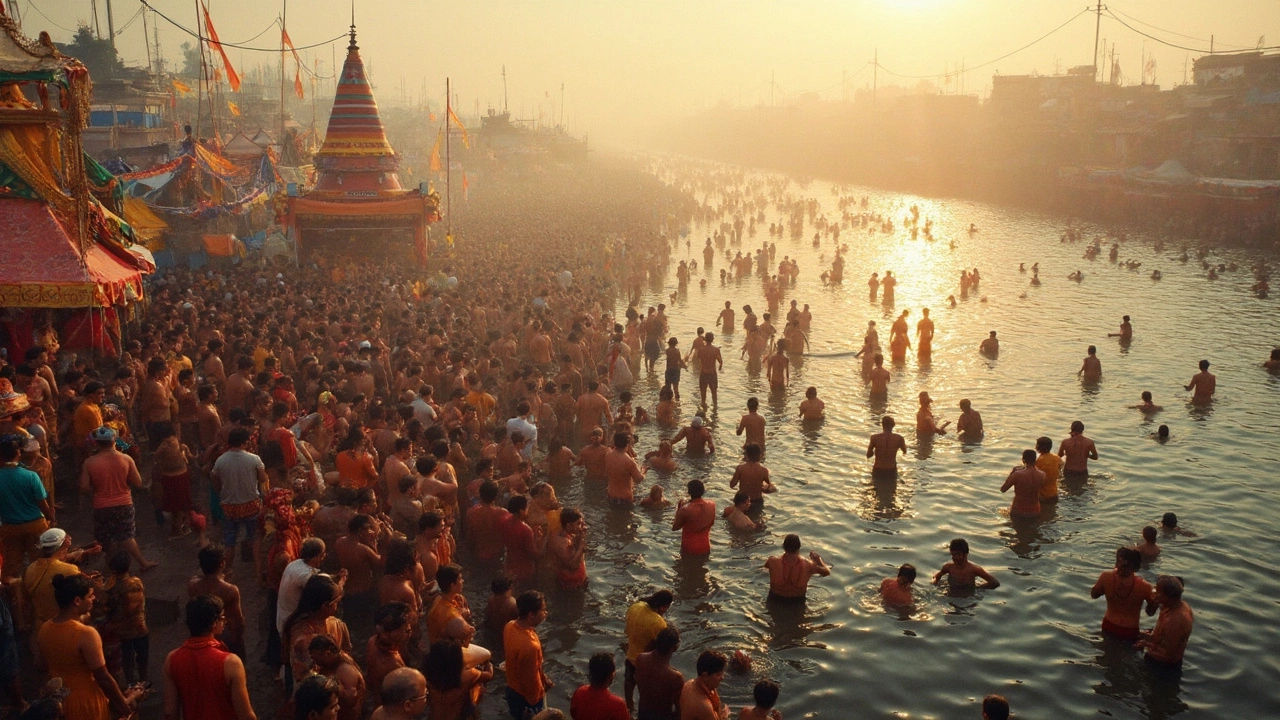Ever hear about a festival that pulls in so many people, it could give some small countries a run for their money? Welcome to the Kumbh Mela—India’s largest religious festival, and a massive congregation of faith, culture, and humanity. This isn’t just any festival; it’s a spiritual magnet for millions who are drawn to sacred riverbanks with the hope of washing away their sins.
What’s mind-blowing about Kumbh Mela is how it rotates among four magical cities—Haridwar, Allahabad, Nashik, and Ujjain—each offering a unique vibe and energy. This rotation happens every three years, making each destination host this mega event approximately every twelve years. The planning, timing, and sheer scale of it all are as riveting as the festival itself.
If temple tours in India are on your bucket list, syncing your travel plans with the Kumbh Mela could give you a front-row seat to one of humanity’s greatest spiritual shows. Picture colorful processions, endless chants, and a sea of devotees, creating an atmosphere that’s nothing short of electrifying.
But timing is key. The festival dates aren't just plucked out of thin air—they’re meticulously calculated based on astrological positions. Understanding these dates can elevate your experience, embroiling you deeper into the tapestry of tradition and belief that forms the essence of this festival. So, want some practical tips for diving into this epic event? Stay tuned!
- The Significance of Kumbh Mela
- How Kumbh Mela Rotates Locations
- Experiencing the Festival on a Temple Tour
- Practical Tips for Visiting the Kumbh Mela
The Significance of Kumbh Mela
The Kumbh Mela isn't just a festival; it's a lifeline of spiritual renewal for millions across India and around the world. Considered the largest gathering of its kind, this mega festival has roots that stretch way back into ancient Hindu mythology. According to legend, gods and demons fought over a pot (or 'kumbh') of nectar, leading to its drops falling in four locations—Haridwar, Allahabad (Prayagraj), Nashik, and Ujjain—where the festival now rotates.
During the Kumbh Mela, these cities transform into a sprawling canvas of devotion. Pilgrims gather at the banks of sacred rivers, like the Ganges in Haridwar, to take a holy dip believed to cleanse them of sins and end the cycle of rebirth. It’s this belief in the purification of the soul that fuels the immense devotion and fervor surrounding the festival.
What's fascinating is the precise astronomical calculations that determine the timing of Kumbh Mela. It's typically held when Jupiter enters Aquarius and the Sun enters Aries, different each time based on celestial alignments. This adds a cosmic weight to the significance of the event. As the philosopher Aldous Huxley once noted, "The charm of history and its enigmatic lesson consist in the fact that, from age to age, nothing changes and yet everything is completely different." This quote resonates with the Kumbh Mela as it keeps its ancient core intact while evolving with the times.
Here's something cool: a survey revealed that a whopping 30 million people visited the Kumbh Mela site in Allahabad in a single day during the 2013 event, setting a world record for the largest human gathering. This sheer number is a testament to the festival’s significance in people’s spiritual journeys.
“Kumbh Mela is a timeless phenomenon, drawing pilgrims to conquer the inner darkness with the light of faith,” Swami Sivananda Saraswati, a revered Hindu guru, once remarked.
The Kumbh isn’t just about religious rituals; it's a giant networking hub too. Sadhus, or holy men, from various sects converge here, sharing wisdom and traditions. For many visitors, this is a chance to connect with spiritual leaders and gain insights into ancient practices that aren't easily accessible elsewhere.
This festival isn’t just a chance to watch religious and cultural extravaganza; it's an opportunity to witness and participate in a profound collective journey that transcends the mundane to embrace the divine.
How Kumbh Mela Rotates Locations
If you're curious about how the colossal Kumbh Mela decides where to set up its spiritual tent, it's all thanks to a fascinating process steeped in tradition and astronomy. The Kumbh Mela doesn’t happen in the same spot every time, and that’s part of what makes it so special. It rotates among four holy cities: Haridwar, Allahabad (now known as Prayagraj), Nashik, and Ujjain.
So, why do these locations get to host this grand event? It has a lot to do with each city’s unique connection to Hindu mythology and their sacred rivers. Now, this isn’t just a random pick from a hat—no way! Ancient scriptures dictate which city gets the honor based on the positions of the Sun, Moon, and Jupiter. Remember making those complex solar system models in school? It’s kind of like that but way more traditional and spiritual.
| City | River | Frequency |
|---|---|---|
| Haridwar | Ganges | Every 12 Years |
| Prayagraj | Sangam (Ganges, Yamuna, Saraswati) | Every 12 Years |
| Nashik | Godavari | Every 12 Years |
| Ujjain | Shipra | Every 12 Years |
The festival follows a 12-year cycle called the Purna Kumbh, but there’s also the Ardh Kumbh, which occurs every six years, and is only held in Haridwar and Prayagraj. If you’re trying to catch this festival, keep your eye on the celestial charts—because when all three planets align in the right positions, it’s time to pack your bags for a spiritual adventure!
Understanding this rotation helps you plan better, adding not just a geographical flavor to your visit but also a deeper understanding of what shapes one of the largest gatherings on the planet. Got goosebumps already? Yeah, same here!

Experiencing the Festival on a Temple Tour
Imagine being part of a tradition that’s older than some of the world’s oldest civilizations. A Kumbh Mela visit is just that—a journey not just through bustling crowds, but deep into the spiritual heart of India. This journey is perfect for those on a temple tour in India, providing a rare glimpse into faith practiced on an epic scale.
Each city hosting the Kumbh Mela boasts its own set of sacred sites and temples, with locations like Allahabad (recently renamed to Prayagraj) standing out due to the confluence of three holy rivers: Ganges, Yamuna, and the mythical Saraswati. This sacred meeting point, called the “Triveni Sangam,” is where pilgrims take the famed dip.
As a traveler on a temple tour, your itinerary might kick off with visiting the majestic Moti Masjid or marveling at the artistic finesse of the Khusro Bagh. Each site isn't just rooted in history, but often tied to legends and tales celebrated during the festival.
“Kumbh Mela is not just a festival, it’s a celebration of life. The stories, the people, the devotion—it’s an experience that stays with you,” remarks acclaimed travel writer Paul Theroux.
If you plan to soak it all in, here’s a little heads-up: accommodation becomes a hot commodity during the Mela. From tents bedecked with all the essentials to luxurious setups catering to spiritual tourists, there's something for everyone. But booking in advance? Absolutely essential!
Connecting with local guides is a game-changer, as they can navigate you through the cultural nuances, ensuring you don’t miss out on special events or significant temple rituals. They also offer insider tips, like which days are best to avoid the crowds, or where you can catch the most vibrant processions.
- Stay alert—pickpocketing is common in large gatherings.
- Be aware of the “Shahi Snan” days, where the sadhus (holy men) lead rituals; these are prime photo op moments.
- Hydration is key; carry water, but respect local customs by not eating or drinking publicly during fasts.
Embrace comfort and practicality. Outfit wise, think comfortable walking shoes and modest clothing. Remember, experiencing the Kumbh Mela is more than just attending a festival—it’s an unforgettable immersion into India’s spiritual and cultural tapestry.
Practical Tips for Visiting the Kumbh Mela
Planning a trip to the Kumbh Mela can be as exciting as it is daunting. This mega-gathering isn't just another holiday—it's an experience of a lifetime. To make the most of it, you’ll want to tackle it head-on with some preparation. Let’s make sure you’re ready for the ride!
Firstly, it's crucial to know the location and timing, as these events rotate. This means checking ahead to see whether it's in Haridwar, Allahabad, Nashik, or Ujjain during your planned visit.
Here's a tip: Book your accommodation well in advance. Trust me, waiting until the last minute won't do you any favors. With millions flocking to these cities, places fill up fast, and prices can skyrocket.
Getting there might seem tricky, but don't sweat it! India's rail network is super extensive and affordable. Alternatively, nearby airports can get you to your destination, but remember, travel during the festival means lots of crowds everywhere.
It’s a smart move to dive into some local customs and basic Hindi phrases – they’ll go a long way in enhancing your interactions and making the experience richer. Plus, some research on the festival's rituals will help you grasp the significance of what's happening around you.
Everyone's there for that sacred dip in the river, so planning your dip when it's less crowded might save you a bit of a headache. Early mornings are usually less packed. Don’t forget those essentials: think comfortable shoes, sunblock, and water. Trust me, you don’t want fatigue messing with your pilgrimage-vibes.
- Stay Safe: Keep an eye on your belongings. With such big crowds, it's easy to lose track of things.
- Health First: Drink only bottled water and be mindful of what you eat, as your stomach might not be ready for the local street food adventures.
- Local Transport Hacks: Rickshaws and taxis are helpful, but always haggle the price before hopping in.
Lastly, let yourself soak up the atmosphere. It's more than just a religious event—it's a cultural burst that’ll imprint on your memory. Blend in, engage, and open your heart to the colorful spectacle of human devotion and community at its fullest!
